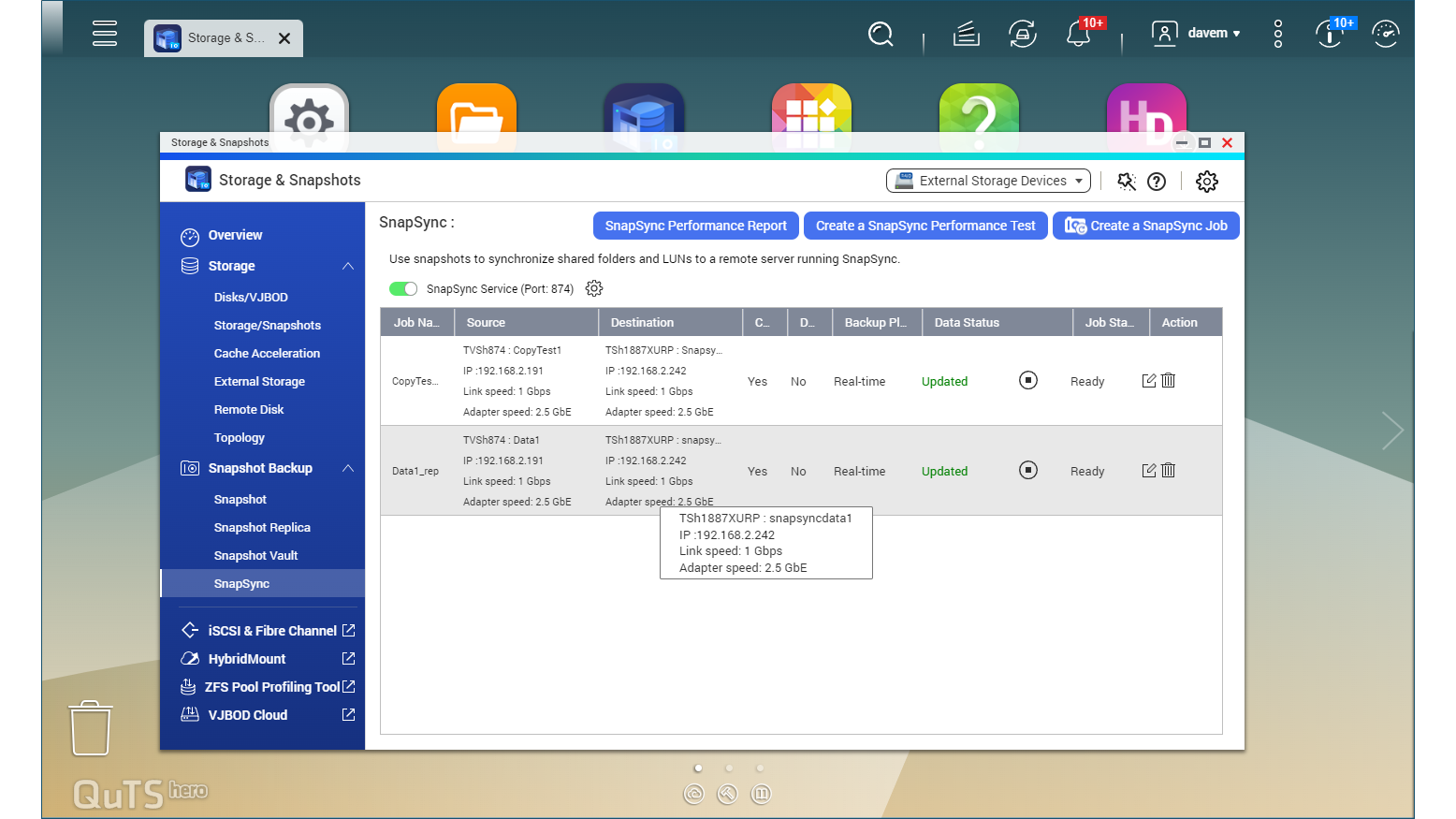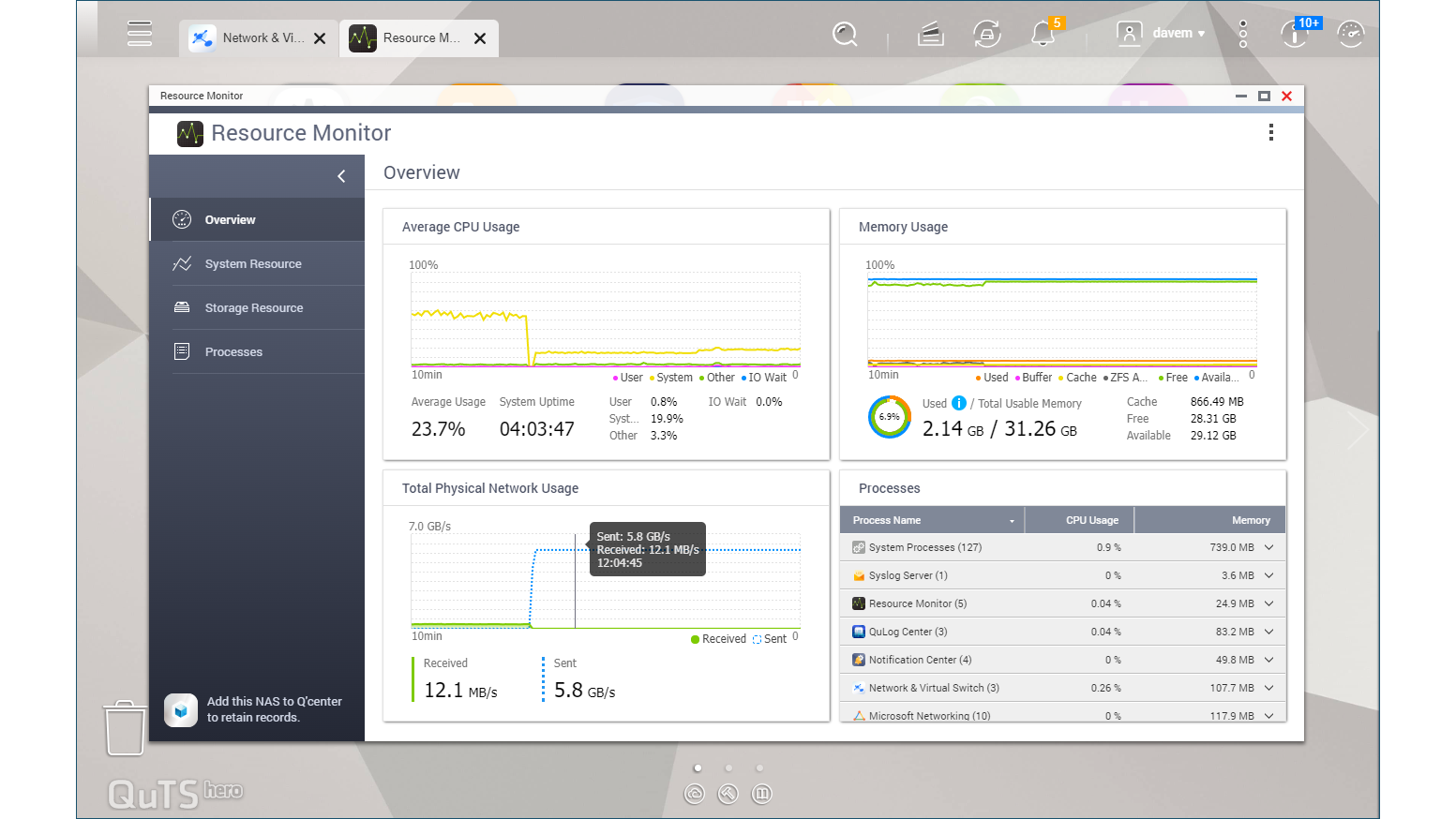Qnap TS-h1887XU-RP review: A powerful hybrid NAS
A small rack NAS appliance with a big storage capacity and excellent performance


-
+
Smart hybrid storage design
-
+
Great 25GbE performance
-
+
Short-depth chassis
-
+
Good expansion potential
-
-
Premium price tag

Qnap's TS-hx87XU-RP family of enterprise-class rack NAS appliances aim to offer storage-hungry businesses a versatile and powerful hybrid solution. Ranging from the 1U 9-bay TS-h987XU-RP up to the 4U 30-bay TS-h3087XU-RP, they all have the same smart design that allows them to team up SATA LFF drives with SFF SSDs to provide a good balance between cost and performance.
On review is the TS-h1887XU-RP which presents twelve standard LFF SATA hot-swap drive bays at the front and six SFF bays at the rear for SATA SSDs. Qnap's thinking is you can keep all your front bays free for high-capacity data storage and use the rear bays to provide a smaller high-speed SSD storage pool or a performance boosting cache.
Two models of the TS-h1887XU-RP are available with the lower-cost version sporting a quad-core 3.4GHz Intel Xeon E-2334 CPU, starting with 16GB of ECC DDR4 memory and costing £4,087. We have the higher-end option which is equipped with a 6-core 2.9GHz Intel Xeon E-2336 CPU and 32GB of memory.
The 'h' in the model names indicate the appliances are geared up to run Qnap's advanced QuTS hero operating system (OS). This is far more memory intensive than Qnap's nimble QTS OS and a key feature of the entire family is they can all be upgraded to 128GB.
Qnap TS-h1887XU-RP review: Design and hardware
Build quality is up to Qnap's usual high standard with the chassis constructed of solid steel and all eighteen non-lockable drive carriers equipped with sturdy metal trays. Another bonus is the chassis is only 547mm deep so it'll easily fit in a data rack cabinet or small wall box.

Under the lid you'll find a tidy interior with easy access afforded to all key components for upgrades. The CPU is fitted with a large passive heatsink and partnered by four DIMM slots with the base 32GB of memory supplied on two 16GB sticks.
Network connections are plentiful as the appliance comes with dual embedded 2.5GbE plus 10GbE RJ45 ports and all four are the multi-Gigabit variety. Even with the two SSD cages at the rear, expansion potential is good as you have three spare PCI-E Gen 4 slots with Qnap offering a choice of 10GbE, 25GbE and 40GbE network cards.
Sign up today and you will receive a free copy of our Future Focus 2025 report - the leading guidance on AI, cybersecurity and other IT challenges as per 700+ senior executives
All cooling is handled by four cold-swap 6cm diameter fans arranged in front of the motherboard with three plastic shrouds used to direct air to the rear SFF bays and over the CPU. Power redundancy is present and correct as the price includes dual 550W hot-plug PSUs.
Qnap TS-h1887XU-RP review: 25GbE performance
For performance testing, we installed QuTS hero on the appliance and used four high-performance 20TB Western Digital Ultrastar DC HC560 HDDs configured as a RAID5 storage pool. To give the appliance a good workout, we fitted it with a Qnap QXG-25G2SF-CX4 dual-port 25GbE adapter and slotted another in a Dell PowerEdge T640 Xeon Scalable tower server running Windows Server 2019.
With a NAS share mapped to the server over 25GbE, we saw excellent Iometer sequential read and write rates of 23.1Gbits/sec and 23Gbits with random rates settling at 23.1Gbits/sec and 22.5Gbits/sec. The latter two numbers are of particular interest as these show how efficient the QuTS hero ARC (adaptive read cache) and ZIL (ZFS intent log) features are.
Moving over to IP SANs, we created a 1TB iSCSI target, connected the server to it over a single 25GbE link and recorded Iometer sequential read and write speeds of 23.1Gbits/sec and 23Gbits/sec with I/O throughputs using 4KB block sizes measured at 125,800 and 171,800 IOPS. Changing to random operations returned read and write speeds of 23.1Gbits/sec and 22.5Gbits/sec and 123,900 and 86,900 IOPS.
With a dual 25GbE MPIO link to the target, we recorded excellent sequential and random read and write speeds of 46.2Gbits/sec and 42.1Gbits/sec and 46.2Gbits/sec and 37.5Gbits/sec respectively. Throughput results for sequential and random operations increased to 210,500 and 197,800 and 205,700 and 87,600 IOPS.
Qnap TS-h1887XU-RP review: QuTS hero features
A browser-based discovery wizard handles installation and although it offers the choice of loading QTS or QuTS hero, we'll cover the latter here as the TS-h1887XU-RP is primarily designed for this OS. It offers superior enterprise-class data protection features including ZFS copy-on-write for near unlimited NAS and iSCSI LUN snapshots and inline data deduplication and compression.

Data corruption is handled transparently with end-to-end checksums and along with the usual RAID array types, QuTS hero supports triple parity RAID and triple mirroring. NAS shares can also be protected from tampering by applying WORM (write once read many) policies to stop data from being deleted.
Accessed from the Storage & Snapshots app, the SnapSync feature provides fast snapshot backups to remote QuTS appliances using block-level replication run to a schedule or in real-time. Its high capacity makes the TS-h1887XU-RP a great choice as a remote SnapSync repository and we tested this using a Qnap TS-h874 desktop model with the SnapSync service enabled on both appliances.
From the TS-h874, we created real-time SnapSync jobs for two NAS shares using the TS-h1887XU-RP as the replication destination. It's really easy to use and whenever scheduled snapshots ran on the TS-h874, we could see them being instantly replicated to the destination host.
Qnap TS-h1887XU-RP review: Verdict
The TS-h1887XU-RP is quite pricey but its smart hybrid design makes it very versatile as support for eighteen storage devices allows you to mix and match SATA HDDs and SSDs to handle a wide variety of workloads. The choice of Qnap's QTS and QuTS hero OSes adds extra flexibility although we think the latter is the better bet as it offers far more data protection services and the appliance's 32GB of memory is enough to enable all key features.
The appliance is well built and its pairs of embedded 2.5GbE and 10GbE ports add extra value. It has plenty of room for further expansion and the Xeon E-2336 CPU delivered excellent results in our 25GbE NAS and IP SAN performance tests.
Qnap TS-h1887XU-RP review specifications
| Chassis | 2U rack chassis |
| CPU | 2.9GHz 6-core Intel Xeon E-2336 |
| Memory | 32GB ECC DDR4 UDIMM (max 128GB) |
| Storage | 12 x SATA LFF/SFF (front), 6 x SATA SFF (rear) |
| RAID | RAID0, 1, 5, 6, 10, 50, 60, Triple Mirror, Triple Parity |
| Expansion | 3 x PCI-E Gen 4 |
| Network | 2 x 2.5GbE, 2 x 10GbE RJ45 (all multi-Gigabit) |
| Other ports | 4 x Type-A USB 3.2 Gen 2 |
| Power | 2 x hot-plug 550W PSUs |
| Management | Web browser |
| Warranty | 3 year limited |
Dave is an IT consultant and freelance journalist specialising in hands-on reviews of computer networking products covering all market sectors from small businesses to enterprises. Founder of Binary Testing Ltd – the UK’s premier independent network testing laboratory - Dave has over 45 years of experience in the IT industry.
Dave has produced many thousands of in-depth business networking product reviews from his lab which have been reproduced globally. Writing for ITPro and its sister title, PC Pro, he covers all areas of business IT infrastructure, including servers, storage, network security, data protection, cloud, infrastructure and services.
-
 Trump's AI executive order could leave US in a 'regulatory vacuum'
Trump's AI executive order could leave US in a 'regulatory vacuum'News Citing a "patchwork of 50 different regulatory regimes" and "ideological bias", President Trump wants rules to be set at a federal level
By Emma Woollacott Published
-
 Microsoft Excel is still alive and kicking at 40 – and it's surging in popularity as 82% of finance professionals report ‘emotional attachment’ to the spreadsheet software
Microsoft Excel is still alive and kicking at 40 – and it's surging in popularity as 82% of finance professionals report ‘emotional attachment’ to the spreadsheet softwareNews A recent survey found Gen Z and Millennial finance professionals have a strong “emotional attachment” to Microsoft Excel
By Emma Woollacott Published
-
 LastPass hit with ICO fine after 2022 data breach exposed 1.6 million users – here’s how the incident unfolded
LastPass hit with ICO fine after 2022 data breach exposed 1.6 million users – here’s how the incident unfoldedNews The impact of the LastPass breach was felt by customers as late as December 2024
By Emma Woollacott Published
